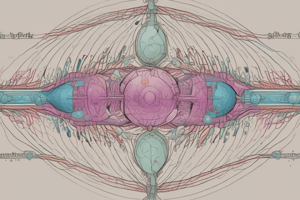Podcast
Questions and Answers
Which of the following is NOT a common dietary fuel?
Which of the following is NOT a common dietary fuel?
- Fats
- Alcohol (correct)
- Carbohydrates
- Proteins
Which hormone regulates blood glucose levels by promoting the uptake of glucose into cells?
Which hormone regulates blood glucose levels by promoting the uptake of glucose into cells?
- Epinephrine
- Insulin (correct)
- Glucagon
- Cortisol
What is the caloric value of carbohydrates per gram?
What is the caloric value of carbohydrates per gram?
- 4 Calories (correct)
- 3 Calories
- 2 Calories
- 5 Calories
Which fuel store in the body has the highest energy storage capacity?
Which fuel store in the body has the highest energy storage capacity?
What stimulates insulin secretion?
What stimulates insulin secretion?
Which organ is a major consumer of glucose?
Which organ is a major consumer of glucose?
Which of the following is true about glucose utilization in skeletal muscle?
Which of the following is true about glucose utilization in skeletal muscle?
What is the caloric value of proteins?
What is the caloric value of proteins?
Which of the following is true about the fates of amino acids?
Which of the following is true about the fates of amino acids?
What is the minimum protein requirement for an average adult human?
What is the minimum protein requirement for an average adult human?
During prolonged fasting, what is the main source of fuel for the body?
During prolonged fasting, what is the main source of fuel for the body?
What happens to glucose uptake by the brain during prolonged fasting?
What happens to glucose uptake by the brain during prolonged fasting?
What is the fate of lactate formed from anaerobic glycolysis in red blood cells during prolonged fasting?
What is the fate of lactate formed from anaerobic glycolysis in red blood cells during prolonged fasting?
What is the effect of prolonged fasting on the breakdown of muscle proteins into amino acids?
What is the effect of prolonged fasting on the breakdown of muscle proteins into amino acids?
Which of the following is true about kwashiorkor and marasmus?
Which of the following is true about kwashiorkor and marasmus?
Which macronutrient contains the highest caloric value per gram?
Which macronutrient contains the highest caloric value per gram?
What is the primary form of fat found in food?
What is the primary form of fat found in food?
What is the primary storage form of glucose in our body?
What is the primary storage form of glucose in our body?
During fasting, the blood glucose level drops initially, but is then maintained at a lowered level by gluconeogenesis from non-carbohydrate sources.
During fasting, the blood glucose level drops initially, but is then maintained at a lowered level by gluconeogenesis from non-carbohydrate sources.
During the fed state, insulin promotes the synthesis of glycogen from excess glucose in the liver. Glucose is taken up by the brain and is converted to acetyl CoA via glycolysis and the pyruvate dehydrogenase complex. Acetyl CoA then enters the TCA cycle where it is oxidized to form carbon dioxide. Subsequently, ATP is generated via oxidative phosphorylation.
During the fed state, insulin promotes the synthesis of glycogen from excess glucose in the liver. Glucose is taken up by the brain and is converted to acetyl CoA via glycolysis and the pyruvate dehydrogenase complex. Acetyl CoA then enters the TCA cycle where it is oxidized to form carbon dioxide. Subsequently, ATP is generated via oxidative phosphorylation.
Urea excretion is very low when consuming glucose only. It increases markedly in the initial phase of fasting, because muscle proteins are supplying amino acids for gluconeogenesis.
Urea excretion is very low when consuming glucose only. It increases markedly in the initial phase of fasting, because muscle proteins are supplying amino acids for gluconeogenesis.
Glycogen is hydrated to four times its weight by water. 50 kg X 4 = 200 kg of glycogen
Glycogen is hydrated to four times its weight by water. 50 kg X 4 = 200 kg of glycogen




